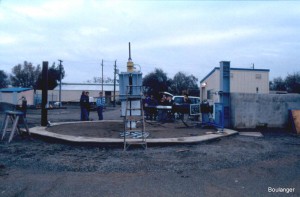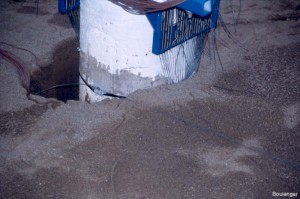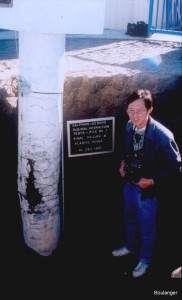This full-scale testing facility for soil-pile interaction was constructed at UC Davis by Professor Rob Chai. It was first used in 1998-99 to test the performance of bridge piles under reversed cyclic loading as produced by earthquakes. The facility is located adjacent to the large centrifuge facilities at the Amorocho Hydraulics Laboratory on the UCD campus. (Link to Chai’s site showing photos of facility construction)

The “test pit” is about 7-m in diameter and 6-m deep below ground. There is a strong beam across the bottom of the pit that provides the reaction for axial loading of the piles. The reaction block for the lateral loading actuator is founded on large-diameter drilled shafts (right side of photo).

This photo shows a test on a common bridge pile under static axial and reversed-cyclic lateral loading. The axial load on the cross-beam is provided by the anchors on each end that extend down to the strong-beam at the test pit bottom. The axial load affects the reinforced concrete pile’s behavior and is an essential part of the test.

A gap has formed between the pile and soil at this stage of the test. When the pile loading direction is reversed, the pile will move through the gap with little resistance until it develops contact with the soil again. This feature of behavior is important to understanding seismic response of pile foundations. Also notice the instrumentation for measuring pile displacements, strains, and curvatures.

The damaged pile is examined after the cyclic testing is completed. A plastic hinge formed in the reinforced concrete pile at a depth of about two pile diameters in this test. These tests provided experimental data on how local damage to piles is related to the pile head displacements, the soil conditions, and other factors.
